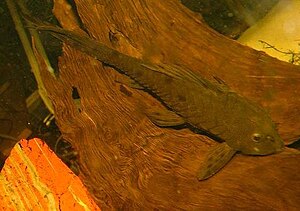Rhinelepinae
| Rhinelepinae | ||||||||||||
|---|---|---|---|---|---|---|---|---|---|---|---|---|

|
||||||||||||
| Systematics | ||||||||||||
|
||||||||||||
| Scientific name | ||||||||||||
| Rhinelepinae | ||||||||||||
| Lujan , Armbruster , Lovejoy & López-Fernándeza , 2014 |
The Rhinelepinae are a subfamily of the South American armored catfish (Loricariidae). They occur in a disjoint distribution area in South America, namely in the upper and middle Amazon basin , in the Mucuri , Río Paraná , Paraíba , Rio São Francisco and Río Uruguay . The group was initially considered the Rhinelepini tribe ( Armbruster , 2004 ) within the subfamily Hypostominae and was elevated to family rank by Lujan and colleagues in mid-2014.
features
The species of Rhinelepinae are relatively large (50-70 cm) and have a typical catfish shape with a flattened body and a flat head with a suction mouth below. Their very thick, protruding bone plates are striking, which is why they are often called pine cone catfish in German . Diagnostic features of the group are the five branched fin rays of the anal fin , the absence of the postdorsal bone crest, the prominent position of the coracoid in the shoulder girdle and a round pupil without the omega- shaped iris lobe typical of armored catfish. The gill cover is angular. An adipose fin is missing. The anus is far back, just before the anal fin. The Rhinelepinae have an unusually large number of teeth, up to 96, the roots of which are much longer than those of other catfish.
Reproduction
Reproduction is only known for the genus Rhinelepis , which, unlike most other catfish, do not care for the brood, but release a huge number of tiny eggs into the free water.
Systematics
| The systematic position is illustrated by the following cladogram : | |||||||||||||||||||||||||||||||||||||||||||||
|---|---|---|---|---|---|---|---|---|---|---|---|---|---|---|---|---|---|---|---|---|---|---|---|---|---|---|---|---|---|---|---|---|---|---|---|---|---|---|---|---|---|---|---|---|---|
|
|||||||||||||||||||||||||||||||||||||||||||||
The Rhinelepinae currently comprise only three genera with six species:
-
Pogonopoma Regan, 1904
- Pogonopoma obscurum Quevedo & Reis 2002
- Pogonopoma parahybae (Steindachner 1877)
- Pogonopoma Wertheimeri (Steindachner 1867)
-
Pseudorhinelepis Bleeker, 1862
- Pseudorhinelepis genibarbis Valenciennes 1840
-
Rhinelepis Agassiz, 1829
- Rhinelepis aspera Spix & Agassiz 1829
- Rhinelepis strigosa Valenciennes 1840
swell
- The Loricariidae by Dr. Jonathan Armbruster: Rhinelepini, Armbruster 2004
- Ingo Seidel: Harnischwelszucht. Tetra Verlag, Berlin 2010, ISBN 978-3-89745-139-1
Individual evidence
- ↑ a b Lujan, NK, Armbruster, JW, Lovejoy, N. & López-Fernández, H. (2014): Multilocus molecular phylogeny of the suckermouth armored catfishes (Siluriformes: Loricariidae) with a focus on subfamily Hypostominae. Molecular Phylogenetics and Evolution, September 2014. DOI: 10.1016 / j.ympev.2014.08.020